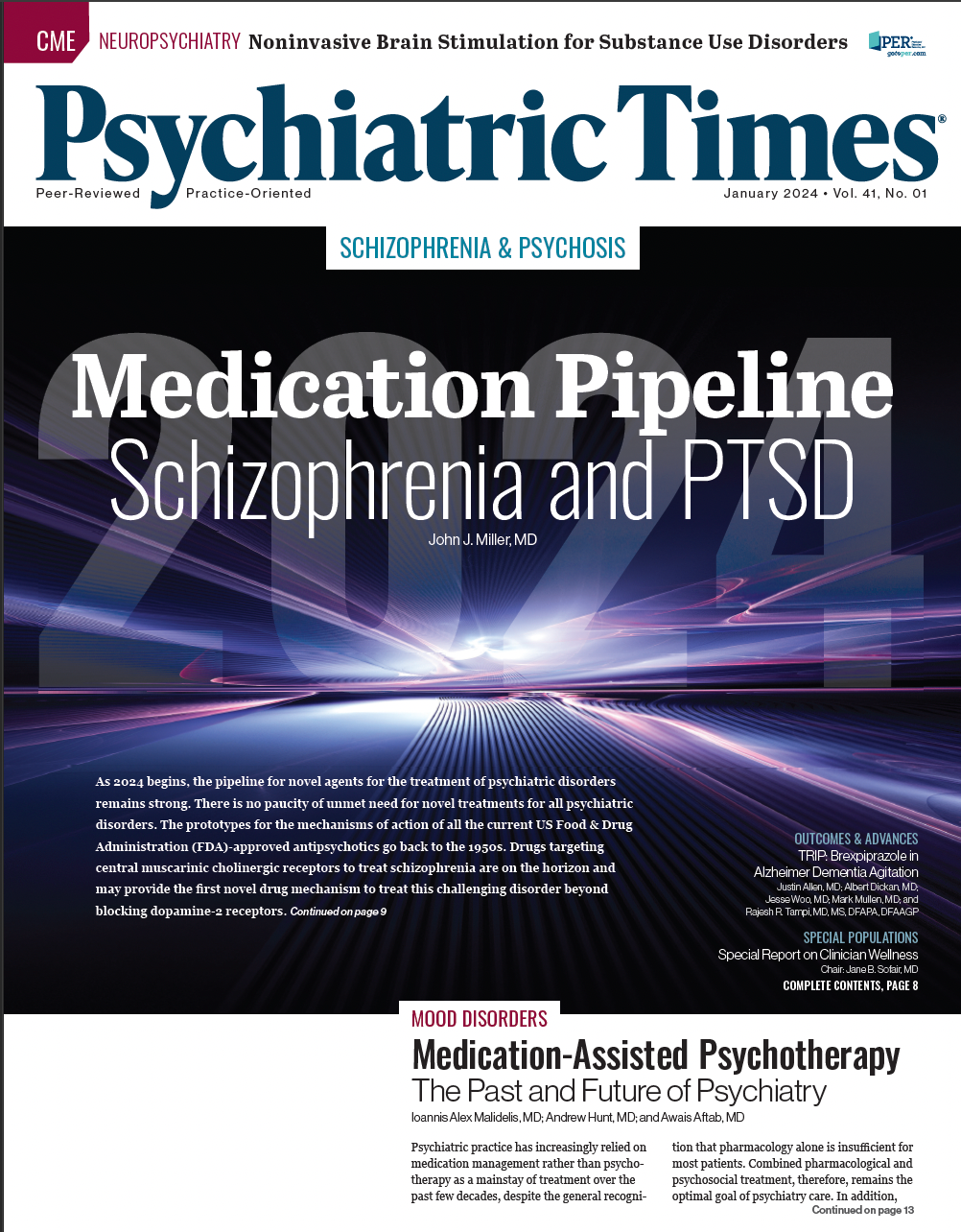News
Article
Psychiatric Times
Medication Pipeline: Schizophrenia and PTSD
Author(s):
Here's an update on which medications are on the horizon for the treatment of schizophrenia and PTSD.
BazziBa_AdobeStock

As 2024 begins, the pipeline for novel agents for the treatment of psychiatric disorders remains strong. There is no paucity of unmet need for novel treatments for all psychiatric disorders. The prototypes for the mechanisms of action of all the current US Food & Drug Administration (FDA)-approved antipsychotics go back to the 1950s. Drugs targeting central muscarinic cholinergic receptors to treat schizophrenia are on the horizon and may provide the first novel drug mechanism to treat this challenging disorder beyond blocking dopamine-2 receptors.
Despite cognitive and negative symptoms significantly contributing to functional impairment in patients with schizophrenia, we have no FDA-approved drugs targeting these symptoms. Researchers around the world continue to painstakingly search out and develop new medications in the hope of developing treatments to address this huge unmet need.
Impressive results from clinical trials during the past decade utilizing a model of medication-assisted psychotherapy are providing hope to individuals with severe posttraumatic stress disorder (PTSD). One such treatment appears close to applying for FDA approval.
In this first part of a 2-part series reviewing novel agents in the psychiatric pipeline, the focus will be on treatments for schizophrenia, including the positive, negative, and cognitive symptoms, as well as a novel approach to treating PTSD. Next month’s part 2 will review novel agents for the treatment of unipolar major depressive episodes and attention-deficit/hyperactivity disorder (ADHD).
Novel Tx for Schizophrenia
KarXT
Acetylcholine (ACh) is believed to be the original neurotransmitter in the evolutionary history of the nervous system. The initial source of ACh was the plentiful supply of choline, which is a chemical building block for cell membrane synthesis by single-celled organisms. With evolution, there are now 2 kinds of receptors for ACh known as nicotinic and muscarinic. Both of these receptor families have been considered targets for drug development. An example of targeting the nicotinic receptor is varenicline (Chantix) for smoking cessation.
However, for KarXT, we will focus on the family of muscarinic receptors. Muscarinic cholinergic receptors (mAChRs) are all known as G protein–coupled receptors with 5 subfamilies (M1-M5) and are diverged from the G protein coupled–receptor superfamily of receptors between 0.5 billion and 1 billion years ago. Unsurprisingly, ACh is a foundational neurotransmitter in humans, with critical functions throughout the brain and body.1
Research dating back to 1957 demonstrated that the naturally occurring mAChR agonist arecoline, which occurs in the betel nut, resulted in “lucid intervals” when given to patients with schizophrenia.2,3
In the 1990s, a synthetic structural analogue of arecoline, xanomeline, was studied in patients with Alzheimer disease, where it demonstrated improvement in cognition and a decrease in psychotic symptoms when present in these patients. This led to a subsequent study in individuals with treatment-resistant schizophrenia where antipsychotic and improved cognitive function was observed.
However, further development of xanomeline was halted at the time due to tolerability challenges that commonly occur with direct muscarinic agonists that come from unwanted stimulation of peripheral muscarinic receptors, such as nausea or vomiting, diarrhea, sweating, and salivation. If this group of adverse effects sounds familiar, it is probably because they are likely related to overactivation of the parasympathetic nervous system where muscarinic receptors are found at the last synapse innervating the smooth muscle.
Xanomeline is an agonist with selectivity at M1 and M4 receptors. Central M1 agonism has been associated with improvement in cognition, attention, and memory consolidation. Central M4 receptors are selectively expressed in the striatum, which is the part of the brain that is believed to be the source of psychosis due to an imbalance of dopamine and ACh.
The presynaptic M4 autoreceptors are agonized by xanomeline, which results in an inhibition of ACh into the synapse. Because the synaptic ACh is believed to facilitate the downstream release of dopamine, which exacerbates psychosis, the result is a decrease in dopamine in the striatum without the need to block any dopamine-2 receptors.
To address these unacceptable adverse effects, Karuna Therapeutics, Inc, hypothesized and clinically confirmed that by adding trospium—a well-established peripherally restricted mAChR antagonist as a combination molecule with xanomeline—the central benefits of mAChRs agonism could be maintained while the trospium would dampen down the adverse effects by antagonizing the peripheral mAChRs (Figures 1 and 2).
Figure 1. Psychosis Present Resulting From Too Much Dopamine (D) in the Nucleus Accumbens
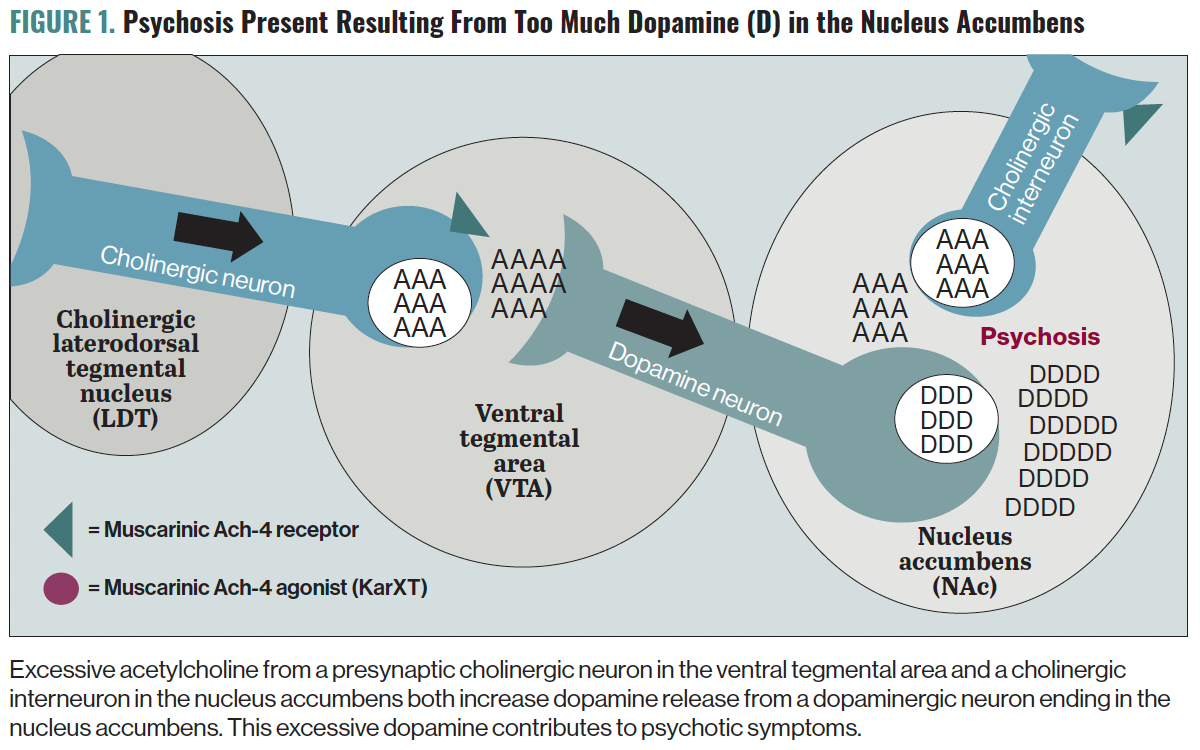
Figure 2. Agonism of Muscarinic Cholinergic 4 Auto-Receptors Decreasing Psychosis
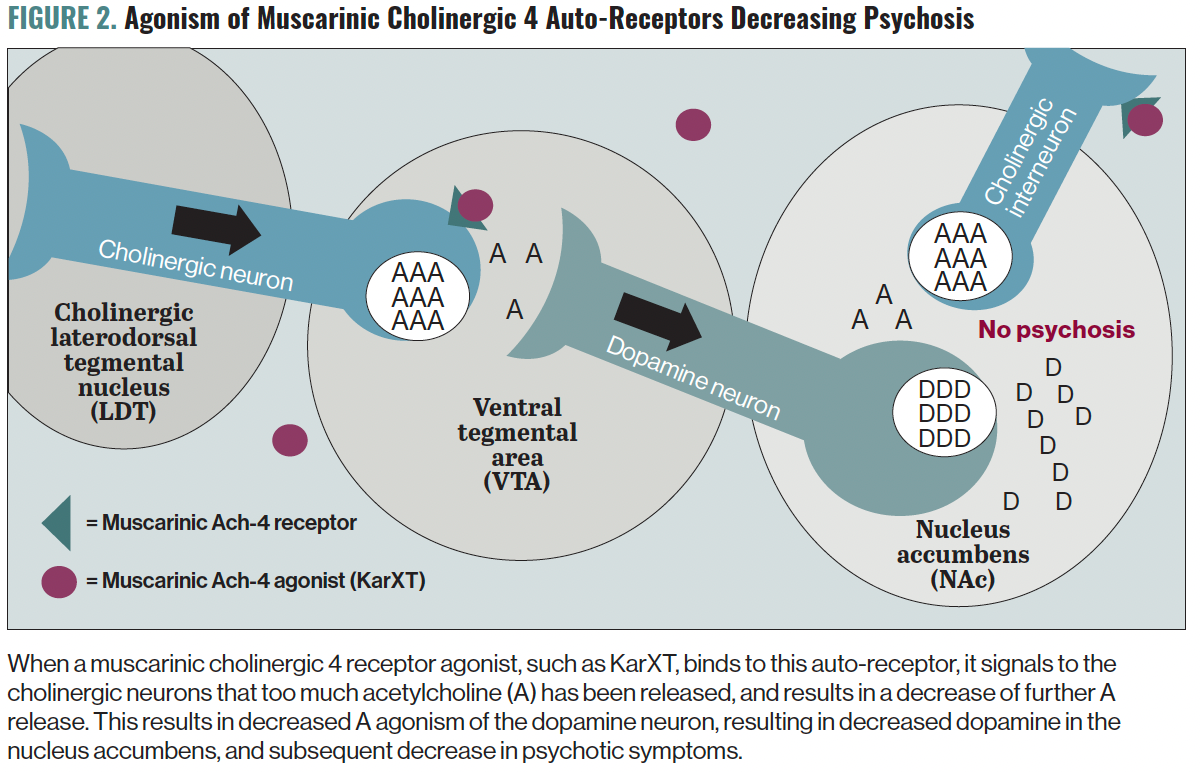
The resulting combination drug xanomeline-trospium was compared with placebo in a phase 2 double-blind trial in individuals with schizophrenia for 5 weeks. Approximately 182 participants were enrolled, with an average Positive and Negative Syndrome Scale (PANSS) score of 97. At 5 weeks, the PANSS score in the xanomeline- trospium group improved –17.4 points vs an improvement of –5.9 points in the placebo group (P < .001).
The most common adverse effects in the active treatment group included constipation, nausea, dry mouth, dyspepsia, and vomiting.4 These phase 2 results were recently replicated by 2 phase 3 trials.
In September 2023, Karuna Therapeutics submitted a new drug application (NDA) to the FDA for KarXT for the treatment of schizophrenia in adults, which was accepted with a Prescription Drug User Fee Act (PDUFA) date of September 26, 2024. If approved, KarXT will become the first antipsychotic medication with no direct effect on the dopamine system.
Clinical Significance
The possible FDA approval of KarXT later this year would be a very big deal in our treatment armamentarium for schizophrenia. All current FDA-approved antipsychotics share the property of antagonizing postsynaptic dopamine-2 (D2) receptors, which is believed to be the mechanism by which they treat psychotic symptoms.
However, due to the diverse brain circuitry that includes postsynaptic D2 receptor antagonism, a range of problematic adverse effects commonly occur. These include many movement disorders, elevation of prolactin, cognitive dulling, and emotional blunting (also referred to as secondary negative symptoms).5
KarXT has no direct activity at any dopamine receptor and putatively indirectly lowers ventral striatal dopamine by presynaptic activity on the cholinergic muscarinic system, which results in decreased presynaptic dopamine release.
Emraclidine
A second mAChR agonist in development for the treatment of schizophrenia by Cerevel Therapeutics is the M4 positive allosteric modulator emraclidine (CVL-231). It is highly specific for M4 and lacks any appreciable agonism at the other mAChRs. In a recent phase 1b trial in individuals with schizophrenia, emraclidine produced clinically meaningful and statistically significant improvement at week 6 compared with placebo in the PANSS total score. Two phase 2 trials are currently underway.6
Emraclidine binds to a region near the M4 receptor’s binding site for ACh and changes the functional structure of the M4 receptor so it is more responsive to agonism by ACh. Hence, less ACh is required to bind the autoreceptor to decrease the presynaptic release of ACh in the striatum, resulting in a decrease of the amount of dopamine released.
Clinical Significance
Like KarXT, emraclidine targets the cholinergic muscarinic system with no affinity to any dopamine receptors. It is currently in early development, and we must patiently await results from the 2 phase 2 trials. An unanswerable question at this time is whether its highly selective affinity for the M4 receptor—with no significant activity at the M1, M2, M3, or M5 receptors—is a benefit or limits its clinical effectiveness.
Iclepertin (Cognitive Symptoms in Schizophrenia)
Prior to the FDA approval of chlorpromazine for the treatment of schizophrenia in 1954, there were no medications approved to treat any of the 3 subdomains of schizophrenia: positive, negative, or cognitive symptoms. The term dementia praecox, which was popularized by psychiatrist Emil Kraepelin in the early 1900s, described a chronic psychotic disorder with significant progressive cognitive decline that usually began in the late teens/early adulthood.
Dementia praecox was a common diagnosis for individuals who were institutionalized in state psychiatric facilities. By the 1950s, dementia praecox and schizophrenia were used interchangeably, and the use of dementia praecox slowly disappeared. The initial use of the term dementia praecox highlights the significance of the cognitive impairment component to schizophrenia, which took a backseat once we had chlorpromazine to treat the positive symptoms in 1954.
Today, we still lack any FDA-approved medication to treat the cognitive symptoms despite clinical trials of drugs with diverse mechanisms of action. Iclepertin’s story is grounded in a great deal of basic science that is striving to provide a procognitive medication for schizophrenia.
Any biological system that plays a central role in the function of wide-ranging physiological processes should be complex by nature, such is the case of the N-methyl-D-aspartate glutamate (NMDA) receptor. A range of unique requirements must be met before this receptor fully engages in the neurocircuitry of the brain (Figures 3-6).
Figure 3. Physiological Process of the NMDA Glutamate Receptor, Part 1

Figure 4. Physiological Process of the NMDA Glutamate Receptor, Part 2

Figure 5. Physiological Process of the NMDA Glutamate Receptor, Part 3
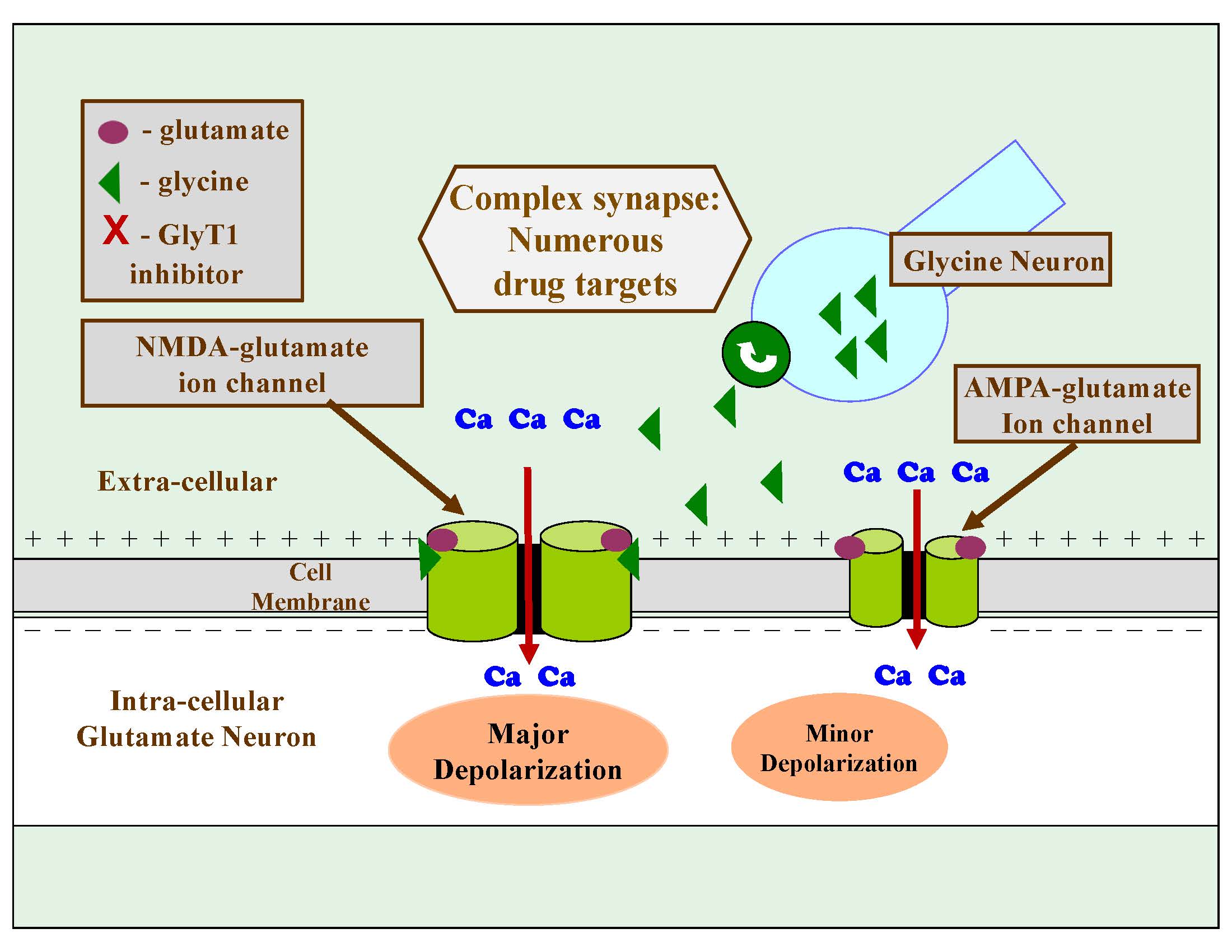
Figure 6. Physiological Process of the NMDA Glutamate Receptor, Part 4
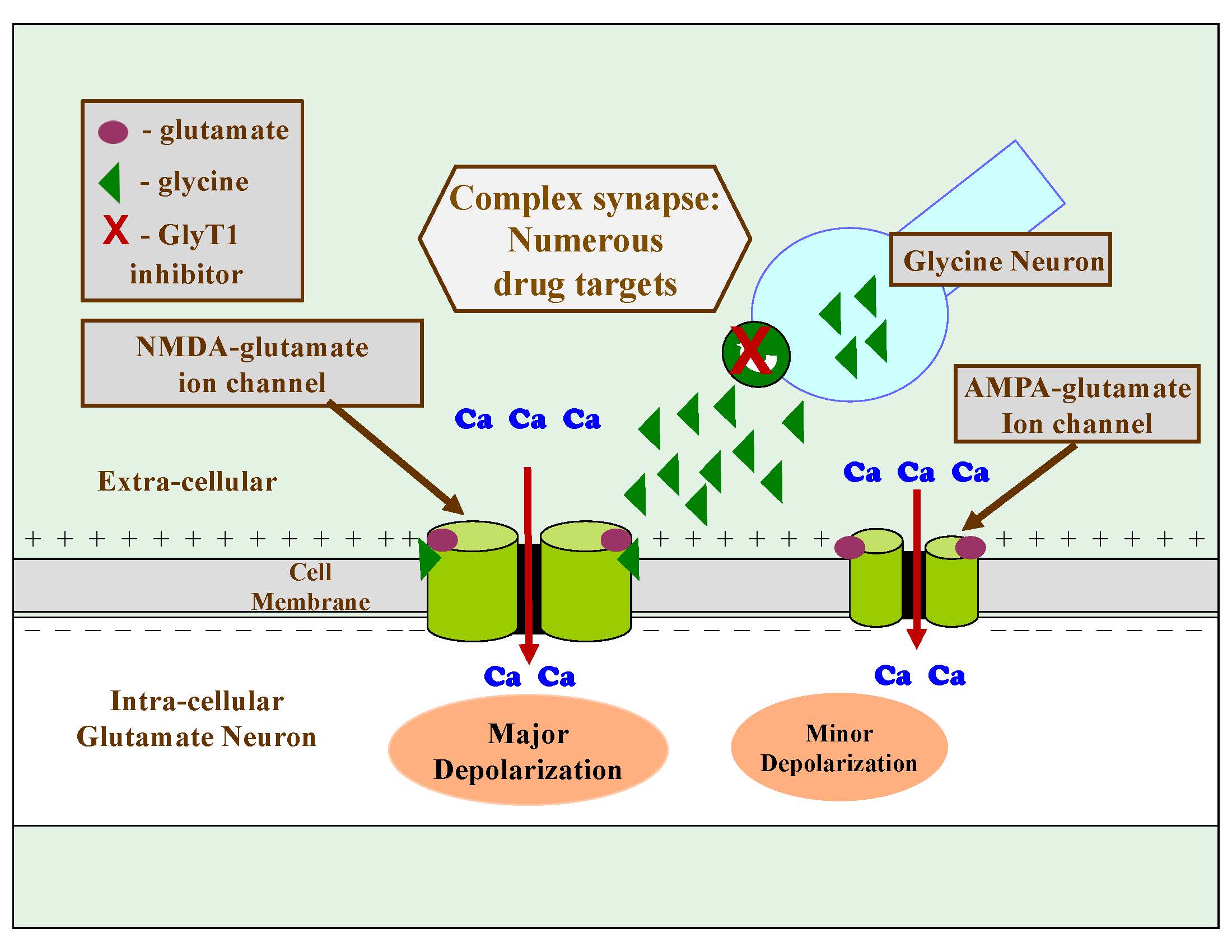
To begin the dance, glutamate must first bind to an adjacent α-amino-3-hydroxy-5 methyl-4-isoxazolepropionic acid glutamate receptor, which results in a minor depolarization of the neuron. This changes the charge of the intracellular environment enough so the Mg++ ions that usually block the NMDA receptor are displaced. This allows calcium ions access to the NMDA receptor channel, but 4 sentries stand firm in the channel, preventing intruders from passing through. However, when the right partner appears, the sentries will gladly abandon their posts.
Two sentries require the accompaniment of the amino acid glutamate, and 2 require the amino acid glycine. Once these 4 couples have been distracted, the channel is wide open and calcium ions freely flow into the neuron, resulting in a major depolarization. A high-maintenance ionotropic receptor like the NMDA receptor provides lots of drug targets to change the course of what happens. It turns out that glycine is an obligatory NMDA receptor coagonist.
The amount of glycine present at the NMDA receptor is controlled by the glycine transporter-1 (GlyT1), which is found in nearby glial cells and presynaptic neurons. Two GlyT1 inhibitors—sarcosine and bitopertin—have been developed but demonstrate suboptimal benefits for cognitive and negative symptoms of schizophrenia. Iclepertin is a potent and selective GlyT1 inhibitor currently in development to treat cognitive impairment associated with schizophrenia (CIAS).
A phase 1 study in healthy male volunteers demonstrated that a once-daily liquid formulation of iclepertin in the dose range of 10 mg to 25 mg (the dose range predicted to be clinically relevant) resulted in a favorable pharmacokinetic profile. In this dose range, it was found to be safe and well tolerated. A subsequent phase 1 trial demonstrated that increasing iclepertin doses increased both plasma and cerebrospinal fluid (CSF) iclepertin levels, with an accompanying dose-dependent increase in CSF glycine levels.
A phase 2 randomized, double-blind, placebo-controlled, parallel-group trial investigated the improvement in CIAS in 509 adult male and female patients with a diagnosis of schizophrenia per the DSM-5. This study took place at 81 centers in 11 countries, randomly assigning patients to 2 mg, 5 mg, 10 mg, 25 mg, or placebo as once-daily treatment, along with their stable antipsychotic medication for 12 weeks.
The primary end point was change from baseline in the MATRICS Consensus Cognitive Battery at the end of week 12. Both the 10-mg and 25-mg doses demonstrated the greatest cognitive improvement, but the 25-mg dose performed no better than the 10-mg dose. Both doses were safe and well tolerated.
Three multinational phase 3 studies are underway, evaluating iclepertin’s efficacy and safety in improving cognition and daily function in a large population of patients with schizophrenia dosed at 10 mg once a day vs placebo for 26 weeks: CONNEX-1, -2, and -3 trials, with an additional open-label safety extension trial, CONNEX-X.7
Clinical Significance
Progressive cognitive impairment can occur in most serious mental illnesses and is a primary subsyndrome in schizophrenia. With a trail of failed clinical trials by other agents, the GlyT1 inhibitors have demonstrated some efficacy with 2 earlier members of this class: sarcosine and bitopertin. It would be a huge step forward if iclepertin demonstrated statistical clinical efficacy in the improvement of cognitive symptoms in schizophrenia, which remains a significant unmet need.
Roluperidone (Negative Symptoms in Schizophrenia)
Like cognitive symptoms, negative symptoms in schizophrenia remain a huge unmet need. Negative symptoms include low motivation, social isolation, blunted affect, paucity of speech, and anhedonia. Since clozapine’s FDA approval in 1989, each new antipsychotic approval has contained the hope of a signal of improvement in cognitive and negative symptoms, along with the demonstrated improvement in positive symptoms. However, none have demonstrated a clear benefit for either cognitive or negative symptoms.
Negative symptoms can have multiple etiologies, including occurring as a primary subsyndrome in schizophrenia, occurring secondary to the D2 blockade of an antipsychotic in the mesocortical tract, resulting from social withdrawal due to the stigma to which patients with schizophrenia can be exposed, or due to comorbid substance use disorders. In drug development, the first challenge is to enroll a population of individuals with schizophrenia whose negative symptoms appear to be primary.
Roluperidone is a novel molecule that has antagonism at the 5-HT2A, sigma-2, and a-1A adrenergic receptors. It was specifically designed to avoid activity at dopamine receptors. It has been investigated in two 12-week randomized, double-blind, placebo-controlled trials in individuals with schizophrenia who have been symptomatically stable with their positive symptoms but demonstrated significant negative symptoms with a PANSS negative symptoms subscale score >20.
The primary end point was the PANSS-derived negative symptom factor score. A secondary end point was the Personal and Social Performance scale (PSP) total score. All other psychotropic medications were discontinued by 2 days prior to randomization and throughout the study. The only exception was the prn use of the rescue medications lorazepam for agitation, zolpidem for insomnia, and an anticholinergic for emergent EPS. Both studies demonstrated an improvement in the 64-mg roluperidone dose vs placebo in the primary and secondary outcomes.8
Two open-label extension studies that were protocol specified evaluated whether improvement demonstrated in the 12-week, double-blind studies persisted for 24 weeks (trial 1) or 40 weeks (trial 2). In both open-label extension studies, there was continued improvement of negative symptoms and on the PSP.9
Roluperidone developer Minerva Neurosciences, Inc, reported that the FDA filed its NDA for roluperidone for the treatment of negative symptoms in patients with schizophrenia on May 8, 2023. This filing occurred following Minerva’s formal dispute resolution and appeal of the FDA’s original October 2022 refuse-to-file letter. The PDUFA date is February 26, 2024.
Clinical Significance
Treatments for negative symptoms in schizophrenia have remained elusive. The combination of cognitive and negative symptoms contributes greatly to the functional impairment of many patients with schizophrenia. Roluperidone has a unique portfolio of receptor binding affinities with an unclear mechanism of action to explain the possible improvement of negative symptoms in schizophrenia.
Sigma-2 antagonism is poorly understood but may provide neuroprotection. The 5-HT2A and a-1A adrenergic receptor antagonism are familiar receptors in many atypical antipsychotics. If approved, roluperidone will be a welcomed addition to our schizophrenia armamentarium.
Evenamide (Augmentation of Treatment-Resistant Schizophrenia)
Treatment-resistant schizophrenia (TRS) is defined as lack of (or inadequate) response of symptoms of schizophrenia after treatment with 2 antipsychotic medications for an adequate dose and duration. TRS remains a huge clinical challenge, especially after a patient has experienced treatment failure with an adequate trial of clozapine, which is currently the only antipsychotic that is FDA approved for this indication. It has long been hypothesized that glutamatergic dysfunction contributes to treatment resistance.10
Evenamide, a selective inhibitor of voltage-gated Na+ channels, has been shown to normalize glutamate release, demonstrating improvements in animal models of psychosis both as monotherapy and as an adjunct to both first- and second-generation antipsychotics, including clozapine.
A recent phase 2 pilot study designed as a randomized, open-label, rater-blinded study evaluated the efficacy of evenamide when added to existing antipsychotic treatment in 161 patients with TRS. Improvement in the PANSS total scores was monitored at 6 weeks, 6 months, and 1 year. At baseline, patients were moderately to severely ill with predominantly positive symptoms. The PANSS score significantly and steadily improved from baseline to 1 year, and evenamide was well tolerated throughout the study.
This phase 2 study had significant limitations, including lack of a double-blind design, no placebo control, and the COVID-19 pandemic, which limited the research participant enrollment to primarily a single country (initial enrollment was to be multinational). However, it introduces a new glutamate-related mechanism of antipsychotic augmentation to further study as a potential adjunct treatment for patients with TRS.11
Clinical Significance
Evenamide has an intriguing mechanism of action and would be used as an augmentation agent in patients with TRS, including patients not responding to clozapine. It is very early in development but may provide an augmenting agent working through the glutamate system. The early study suggests that symptom improvement occurs over a 1-year period of treatment. This is a drug to watch.
Novel Treatment for PTSD
MDMA-Assisted Therapy for PTSD
A variety of psychotherapies provide the primary current treatment for PTSD, including exposure-based therapy, trauma-focused cognitive behavioral therapy, cognitive therapy, and eye movement desensitization and reprocessing therapy. Despite the high prevalence of PTSD in the United States, only 2 medications—sertraline and paroxetine—are FDA approved to treat PTSD, both with limited efficacy.
Current research supports a model that primarily involves psychotherapy but includes 2 to 3 sessions early on, in which the patient also receives 3,4-methylenedioxymethamphetamine (MDMA) along with manualized therapy with trained therapists. MDMA is an empathogen that results in the presynaptic release of serotonin, as well as the release of neurohormones oxytocin, prolactin, and cortisol.
Clinically, patients taking MDMA report openness, decreased emotional avoidance, increased self-confidence, increased empathy, and increased prosocial feelings and behavior. For subjects with significant past trauma, MDMA has been hypothesized to enhance fear extinction and modulate fear memory reconsolidation, increase trust, and increase emotional learning.12
Multiple phase 213 and phase 3 studies have been completed, published, and have consistently demonstrated a significant improvement of PTSD symptoms. In one phase 3 study, participants with severe PTSD with significant comorbidities began with 3 preparatory therapy sessions, followed by 3 sessions with either MDMA or placebo in combination with manualized therapy, which were then followed by 9 integrative therapy sessions over a total of 18 weeks.
The MDMA-treated group demonstrated “a significant and robust attenuation of PTSD symptoms and functional impairment as assessed using the CAPS-5 [Clinician-Administered PTSD Scale for DSM-5] and SDS [Sheehan Disability Scale], respectively.”14
In a confirmatory, multisite, double-blind, randomized phase 3 study that evaluated the efficacy and safety of MDMA-assisted therapy vs placebo-assisted therapy in individuals with moderate to severe PTSD, significant improvements were found in the primary and secondary end points. This study enrolled an ethno-racially diverse population, with 26.9% of participants having moderate PTSD and 73.1% of participants having severe PTSD.
The CAPS-5 total severity score (primary end point) least squares (LS) mean change was −23.7 (−26.94, −20.44) for MDMA-assisted therapy vs −14.8 (−18.28, −11.28) for placebo with therapy (P < .001, d = 0.7). For the SDS (key secondary end point), the LS mean change was −3.3 (−4.03, −2.60) for MDMA-assisted therapy vs −2.1 (−2.89, −1.33) for placebo with therapy (P = .03, d = 0.4).15
A significant design of these studies is that the psychotherapy is the primary treatment, with the MDMA being used to facilitate the therapeutic process in a small subset of the sessions early on. The combination of MDMA with intensive therapy seems to create a safe holding environment for the patient to be more likely to allow these traumatic memories to surface, be consciously processed, and then be reconsolidated with a decreased emotional charge.
Clinical Significance
Clinical studies continue to demonstrate a significant improvement in patients with severe PTSD using the MDMA-assisted therapy protocol described. The acute treatment protocol of 18 weeks is time- and therapist-intensive but will be well worth this investment if the results demonstrated to date persist.
This medication-assisted psychotherapy model has created an important template to expand into other treatments, which is currently already ongoing in the study of psilocybin-assisted therapy for major depression.
Significantly, on December 12, 2023, MAPS Public Benefit Corp submitted an application to the FDA requesting approval of the combination of MDMA with psychotherapy for PTSD.
Concluding Thoughts
The medications reviewed are but a small sampling of the many candidate drugs in various stages of clinical development for psychiatric disorders. Most psychiatric disorders have no FDA-approved drug, which highlights the need for increased investment at all levels of research and development.
The second part of the pipeline update will appear in the February issue and will review 3 novel agents in clinical trials for the treatment of unipolar major depressive episodes and a novel drug to treat adults with ADHD.
Dr Miller is Medical Director, Brain Health, Exeter, New Hampshire; Editor in Chief, Psychiatric Times; Staff Psychiatrist, Seacoast Mental Health Center, Exeter; Consulting Psychiatrist, Exeter Hospital, Exeter; Consulting Psychiatrist, Insight Meditation Society, Barre, Massachusetts.
References
1. Dean B. Evolution of the human CNS cholinergic system: has this resulted in the emergence of psychiatric disease? Aust N Z J Psychiatry. 2009;43(11):1016-1028.
2. Pfeiffer CC, Jenney EH. The inhibition of the conditioned response and the counteraction of schizophrenia by muscarinic stimulation of the brain. Ann N Y Acad Sci. 1957;66(3):753-764.
3. Sullivan RJ, Allen JS, Otto C, et al. Effects of chewing betel nut (Areca catechu) on the symptoms of people with schizophrenia in Palau, Micronesia. Br J Psychiatry. 2000;177:174-178.
4. Brannan SK, Sawchak S, Miller AC, et al. Muscarinic cholinergic receptor agonist and peripheral antagonist for schizophrenia. N Engl J Med. 2021;384(8):717-726.
5. Correll CU, Angelov AS, Brannan SK. Safety and efficacy of KarXT (xanomeline-trospium) in patients with schizophrenia: results from a phase 3, randomized, double-blind, placebo-controlled trial (EMERGENT-2). Presented at: Psych Congress 2022; September 17-20, 2022; New Orleans, LA.
6. Krystal JH, Kane JM, Correll CU, et al. Emraclidine, a novel positive allosteric modulator of cholinergic M4 receptors, for the treatment of schizophrenia: a two-part, randomised, double-blind, placebo-controlled, phase 1b trial. Lancet. 2022;400(10369):2210-2220.
7. Rosenbrock H, Desch M, Wunderlich G. Development of the novel GlyT1 inhibitor, iclepertin (BI 425809), for the treatment of cognitive impairment associated with schizophrenia. Eur Arch Psychiatry Clin Neurosci. 2023;273(7):1557-1566.
8. Davidson M, Saoud J, Staner C, et al. Efficacy and safety of roluperidone for the treatment of negative symptoms of schizophrenia. Schizophr Bull. 2022;48(3):609-619.
9. Rabinowitz J, Staner C, Saoud J, et al. Long-term effects of roluperidone on negative symptoms of schizophrenia. Schizophr Res. 2023;255:9-13.
10. Moghaddam B, Javitt D. From revolution to evolution: the glutamate hypothesis of schizophrenia and its implication for treatment. Neuropsychopharmacology. 2012;37(1):4-15.
11. Anand R, Turolla A, Chinellato G, et al. Phase 2 results indicate evenamide, a selective modulator of glutamate release, is associated with clinically important long-term efficacy when added to an antipsychotic in patients with treatment-resistant schizophrenia. Int J Neuropsychopharmacol. 2023;26(8):523-528.
12. Wagner MT, Mithoefer MC, Mithoefer AT, et al. Therapeutic effect of increased openness: investigating mechanism of action in MDMA-assisted psychotherapy. J Psychopharmacol. 2017;31(8):967-974.
13. Jerome L, Feduccia AA, Wang JB, et al. Long-term follow-up outcomes of MDMA-assisted psychotherapy for treatment of PTSD: a longitudinal pooled analysis of six phase 2 trials. Psychopharmacology (Berl). 2020;237(8):2485-2497.
14. Mitchell JM, Bogenschutz M, Lilienstein A, et al. MDMA-assisted therapy for severe PTSD: a randomized, double-blind, placebo-controlled phase 3 study. Focus (Am Psychiatr Publ). 2023;21(3):315-328.
15. Mitchell JM, Ot’alora G M, van der Kolk B, et al. MDMA-assisted therapy for moderate to severe PTSD: a randomized, placebo-controlled phase 3 trial. Nat Med. 2023;29(10):2473-2480.
